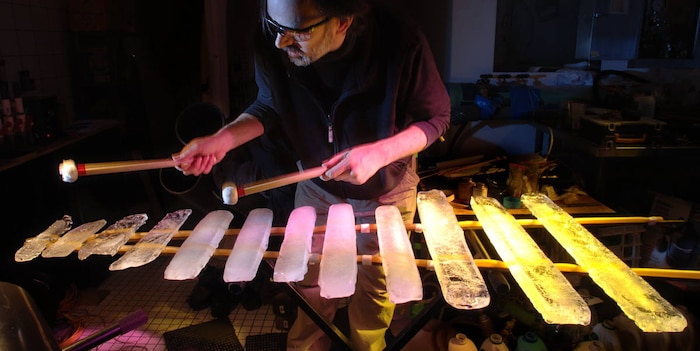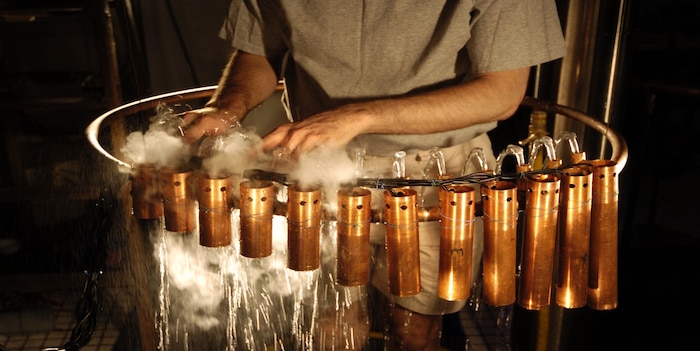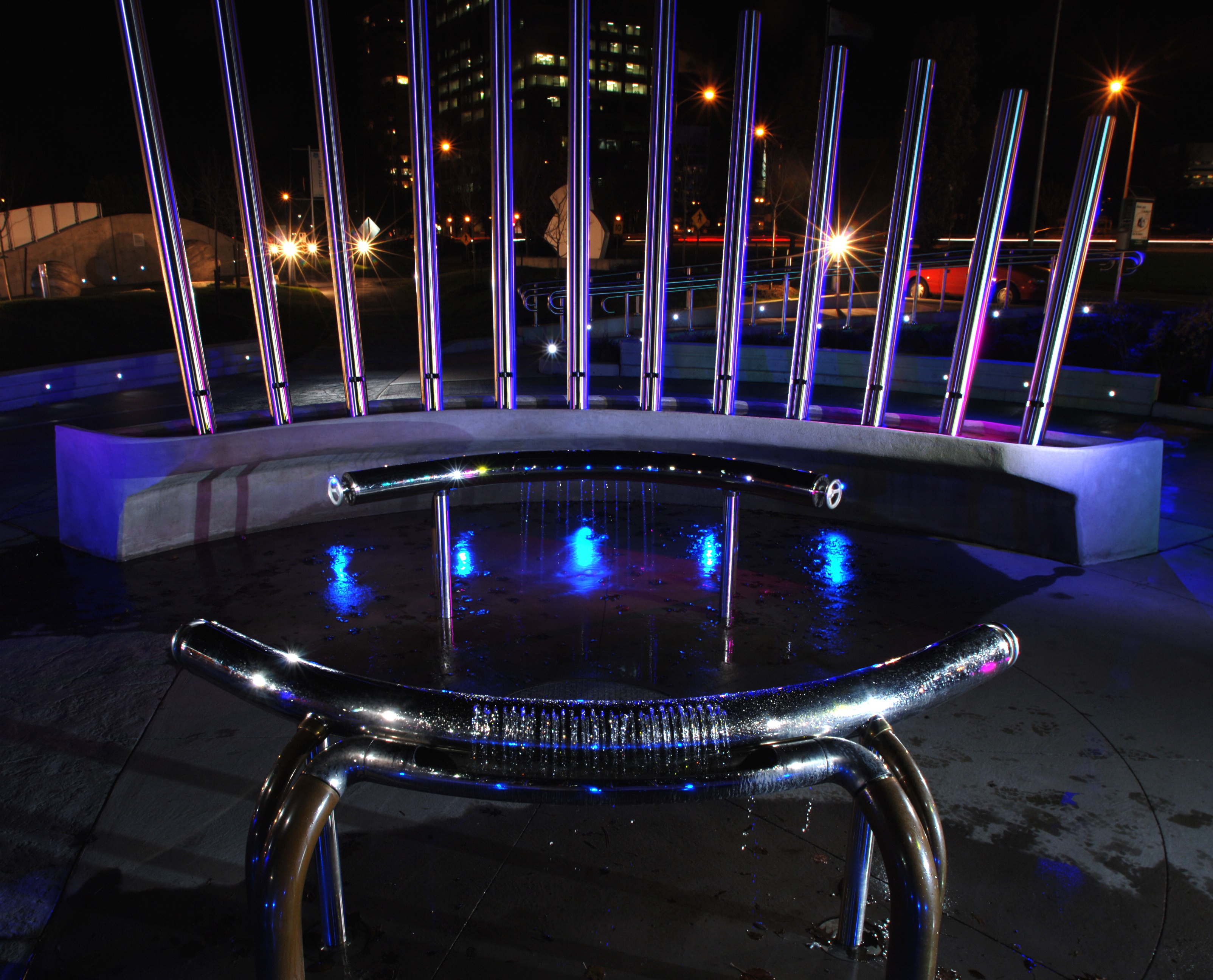Water Music: The Hydraulophone
A leading inventor of cyborg technology pursues a new water-based instrument
.76c0fca0.jpg?auto=format&w=700)
When Steve Mann was a little boy, he realized there was something amiss about the world of music. “My kindergarten teacher told me there are three kinds of instruments: strings, percussion and wind,” he says. “I thought, ‘Well, strings and percussion both make sound from vibrations in solid matter, and wind from gas.’ So I told her, ‘Oh, you mean they’re like the three states of matter: solid, solid and gas.’”
For a kindergartener to deliver that punchline would seem implausibly precocious if the anecdote involved anyone but Mann. An inventor, researcher and professor at the University of Toronto, Mann already enjoys a nerdy kind of celebrity status in Canada due to his early adoption of wearable technology, such as the “EyeTap” digital glasses with which this self-styled cyborg has been recording his existence for several decades.
But before he began envisioning his merger of man and machine, Mann was already thinking about the hydraulophone. That’s his name for the family of instruments he has invented in the hopes of introducing listeners and performers to the realm of possibilities derived from the state of matter that has been left out of the musical discourse for far too long.
“If you look at Neanderthal bone flutes, you can see that people have been making wind instruments for more than 30,000 years,” says Mann in an interview in his lab and design studio across from the Art Gallery of Ontario, which contains many of the hundreds of hydraulophones he’s designed. “Solid instruments have existed for maybe even longer because people banged on drums and so on. Yet nobody has ever made a musical instruments that actually made sound from vibrations in liquid.”
He notes that the one thing needed for such instruments – pressurized water – has been around since the ancient Greeks began building aqueducts. Nevertheless, that anti-liquid bias perplexed the young Mann so much he began developing prototypes for new instruments. In so doing, he demonstrated the sort of industriousness that would be hallmarks of an inventor whose CV also includes developing and patenting HDR (High Dynamic Range) photographic imagery as a Ph.D student at MIT. As for his pioneering work in wearable tech, the 2001 documentary Cyberman showcases Mann creations that essentially predate Google Glass and the Apple Watch by decades.
Though Mann admits that the notion of water music was not entirely new, other forms largely tap-danced around the fundamental challenge of using vibrations in water. For example, in the water drumming practiced by the Baka people in the Central African rainforests – in which the players bang their cupped hands down on the water – the sound actually comes from the air. Same goes for the Wave Organ near the Exploratorium on San Francisco Bay, the Blackpool High Tide Organ and the Sea Organ in Croatia, three acoustic sculptures that harness wave energy to push air up through organ pipes.


Claims for other fluid-based musical precedents are equally slippery. Designed to be performed outdoors, Handel wrote Water Music for a water pageant on the Thames but included no fanfare for fountain when the piece was first performed on King George I’s royal barge in 1717. More recently, the Arcade Fire’s Richard Reed Perry and the National’s Bryce Dessner collaborated on a piece named Wave Movements, in which ocean wave patterns were translated into musical notation, but that’s performed by a conventional orchestra. John Luther Adams’ Pulitzer-winning composition Become Ocean is similarly water-based in conception rather than execution. Nor is there, technically speaking, the sound of water in the greatest of all lonely-rainy-night soul singles, since producer Willie Mitchell used an electric timbale to create the sound of raindrops in Ann Peebles’ “I Can’t Stand the Rain.”
Though some listeners may know the sound of water from the singing or whistling of shower heads and faucets, hearing the hydraulophone is a far different experience. Mann’s flagship model is a reed-based version known as the Clarinessie, or Nessie, as kids like to call it due to its friendly tadpole-like shape. (Says Mann, “When I had the hydraulophone sitting here and my daughter was about four years old, she would put a blanket on Nessie and say, ‘I don’t want her to get cold.’”)
This is the one that Mann and his team hope will someday be widely adopted beyond the water parks and children’s science museums where they’ve mostly found homes over the last decade. The curvy, whimsically colored object is about 60 inches long and two feet wide and powered by a battery pump. Inside are a series of water jets that are laid out and tuned to a musical scale (Mann says A minor and D minor are Nessie’s tonal sweet spots). Notes are then created when players use their fingers to cover the water-spout-like holes, arranged to be equidistant and positioned for ease of playing. Derived from the turbulence caused by the change in the water’s direction, the sound is surprisingly rich and mellifluous.

Mann notes that because of its reeds, the Nessie and its cousin the H2Oboe (which has multiple reeds for each note instead of just one) derive their sound from a mixture of solid-matter vibrations and liquid ones. “It’s just like how a clarinet is not a true wind instrument because it has a combination of solid and gas vibrations,” he says. One of his other models, the Water Flute, may be the more “intellectually pure form” since its only moving element is water, much like air in a flute.
“People are just drawn toward it because water is a primordial element – like music, it’s very innate to us.” - Steve Mann
There are 45 holes in the largest Nessie, a gleaming, self-cleaning two-part contraption that was installed at the Ontario Science Centre in 2006. Other Nessies can be found at the Chicago Children’s Museum and the Experimentarium in Copenhagen. First impressions with the Nessie tend to yield comparisons with a pipe organ, a giant flute and a water fountain. Yet Mann believes his invention may have far different musical properties than anything that’s come before it.
“Polyphonic embouchure is a concept unique to the hydraulophone,” says Mann. “A flute allows you to play very expressively with embouchure control – a piano or an organ doesn’t give you the same degree of control a flute has. If you have 88 flutes instead of a piano, you’ve got a much richer form of flowing, fluidly varying music. With circular breathing, you can make a note as long as you want it to be, whereas with a piano, the note dies out. Now, with an organ, you can sustain the note but you kind of just turn it on and off, you don’t have the same control over the note as it’s progressing.”

For an example of what the hydraulophone can do, Mann cites a performance of Gabriel Faure’s Sicilienne by Ryan Janzen, an expert “hydraulist” who’s also a scientist and composer on Mann’s team. “There’s a version on piano and flute or piano and cello where the piano plays the polyphonic chords part and then the flute or cello plays the very fluidly flowing melody line,” Mann explains. “But what Ryan does is he plays this fluid harmony – he plays both parts at the same time in this sort of polyphonic embouchure. ‘Har-melody’ is what I call it, which is harmony and melody intertwined. It sounds like a whole orchestra playing when he’s just playing this one instrument with that degree of expressivity.”
Mann believes the uniquely tactile experience of playing the hydraulophone makes it a great match for musicians with sight and hearing impairments. The deaf percussionist and composer Evelyn Glennie was duly impressed when Mann gave her a demo at the University of Toronto in 2007. “She just loved the hydraulophone because she can feel the vibrations,” he says. “The human body is mostly made of water, so to have the sound vibrating in water and touching your fingers brings you the sound in a non-cochlear sort of way.”
Indeed, the instrument’s only drawback is the performer’s tendency to get soaked, which may be less of an issue if he or she is playing a hydraulophone that’s built into the side of a hot tub (they’ve made those, too). Mann recommends playing the instrument underwater to avoid such issues – that tactic also silences the babbling-brook sound that may or may not be a desired part of the instrument’s sound palette.
Mann’s family of water-based instruments also includes the pagophone, a xylophone made of ice, and the callioflute, which uses H2O in its gaseous form. But Mann’s team is hoping the Nessie will develop a wider appeal – to further that aim, a company named Splashtones was recently founded to develop a market for a mass consumer model.


“It creates this ineffable sense of awe and wonder in all who touch it,” says Mann of the hydraulophone. “People are just drawn toward it because water is a primordial element – like music, it’s very innate to us.”
He’s confident that the instrument will ultimately overcome any resistance to its adoption, despite the musical establishment’s traditional preference for solids and gases. “Sometimes professional musicians are set in their ways,” he says. “They form a very specific set of training for a specific instrument, so in a way, this is like a new experience. But a new generation of great hydraulists are starting to emerge.”
“One of the things,” he adds, “is that classical music is about ‘the conservatory.’ Like in Canada, we have the Royal Conservatory of Music. I’ve always felt we should have an Inventa-tory of Music.”
